 Our Lady of Justice, Illustration by Angela Berry and Shaun O'Dell.
Our Lady of Justice, Illustration by Angela Berry and Shaun O'Dell.Official Frills
Angela Berry
In French, jabot means gizzard (of a bird) or bird frill. In English, a jabot is a decorative neck piece on the front of a shirt that conceals its closure, most commonly made of cotton or linen with lace trim (fig. 3).1 Without a known epistemological origin, we can understand this piece of fabric as a cocky accessory.2 Jabot is pronounced zha-bō and rhymes with elbow, gazebo, limbo, bimbo, crossbow, oxbow, oboe, dumbo, mumbo-jumbo, flambeau, and rainbow. Jabots rose to fashion when Baroque necklines lowered, decorating skin with ornate details.3 The jabot in plain sight is salacious; at once stimulating, then protecting undigested contents from the wearers crop. A protective spell cascading from Adam’s apple to your heart. The jabot is historically unisex and can be fastened for any occassion. It lays loose for the eyes to mill.

Figure 1 The Supreme Court of the Unites States

Figure 2
Justices wear jabots. Unlike verdicts that travel, jabots fall. Various official costumes in the European Union require jabots, such as the Advocates General of the Court of Justice (fig. 2). A country like the United States with Puritan roots has no need for jabots and they are not mandated. Still, female justices are permitted to dress their official robe with a neck piece. In The Supreme Court of the United States (fig. 1), Associate Justice Elena Kagan does not wear a jabot. For Justice Kagan “the robe is a symbol of the impersonality of the law.”4 Associate Justice Ruth Bader Ginsburg wears jabots (fig. 4).


Figures 3 and 4
In Justice Ginsburg’s vested power to interpret the constitution and make supreme rulings she creates law precisely because of the humanity enacted by her character. In a 2009 interview with The Washington Post, Justice Ginsburg describes her choice to wear a jabot as a response to the reveal in official robes designed to show both a man’s shirt and tie, a cocky accessory, in a sense his character.5 Before Justice Ginsburg’s appointment to The Supreme Court, the first female justice Sandra Day O'Connor was shamed for not pairing her robe with a neck piece. Some Reagan Era look-y-loo sent a personal note to O'Connor stating that the absence of a neck piece presented the look of a "washed-out justice." On the matter O'Connor said, "I didn't know anybody who made robes for women justices." It wasn't until O'Connor was able to share her experience with another female justice that the paradox of wearing menswear to work was addressed. After rumination O'Connor and Ginsburg concluded "it would be appropriate if we included as part of our robe something typical of a woman."6
The jabot is to official frills as acid rain is to memorials on The National Mall, which has slowly dissolved and weakened the marble stone forming Thomas Jefferson and oxidized a bronze Ulysses S. Grant.7 Sulfur dioxide and nitrogen oxide clouds appeared in North America in the mid-20th century after the rise of coal production.8 This acidic rain is an early example of a hyper object as defined by object-oriented philosopher and English Professor at Rice University Timothy Morton. It popularized environmental concern, because it connected the incomprehensible magnitude of ecological disaster with an affecting experience that could not be touched, rather perceived. The observed decline of New England’s sugar maples is one such example (fig. 5).

Figure 5
Nothing save for acid rain appears to be eroding visual signs glorifying male character and authority from The Supreme Court of the United States. Nothing save for acid rain or our female justice’s jabots. Marble iconography portraying men writing, practicing, and protecting law abounds in The Supreme Court Building located at One First Street, NE, Washington D.C. This permanent home for the court was built in 1935 shortly after the U.S. capitol was established. A writer in search of marbleized signs of the patriarchy at One First Street can have her pick. Various architects and artists were enlisted to decorate The Supreme Court Building with images of the historically male character of law, but the work by artists James Earle Fraser and Adolph A. Weinman serves as low-hanging fruit.
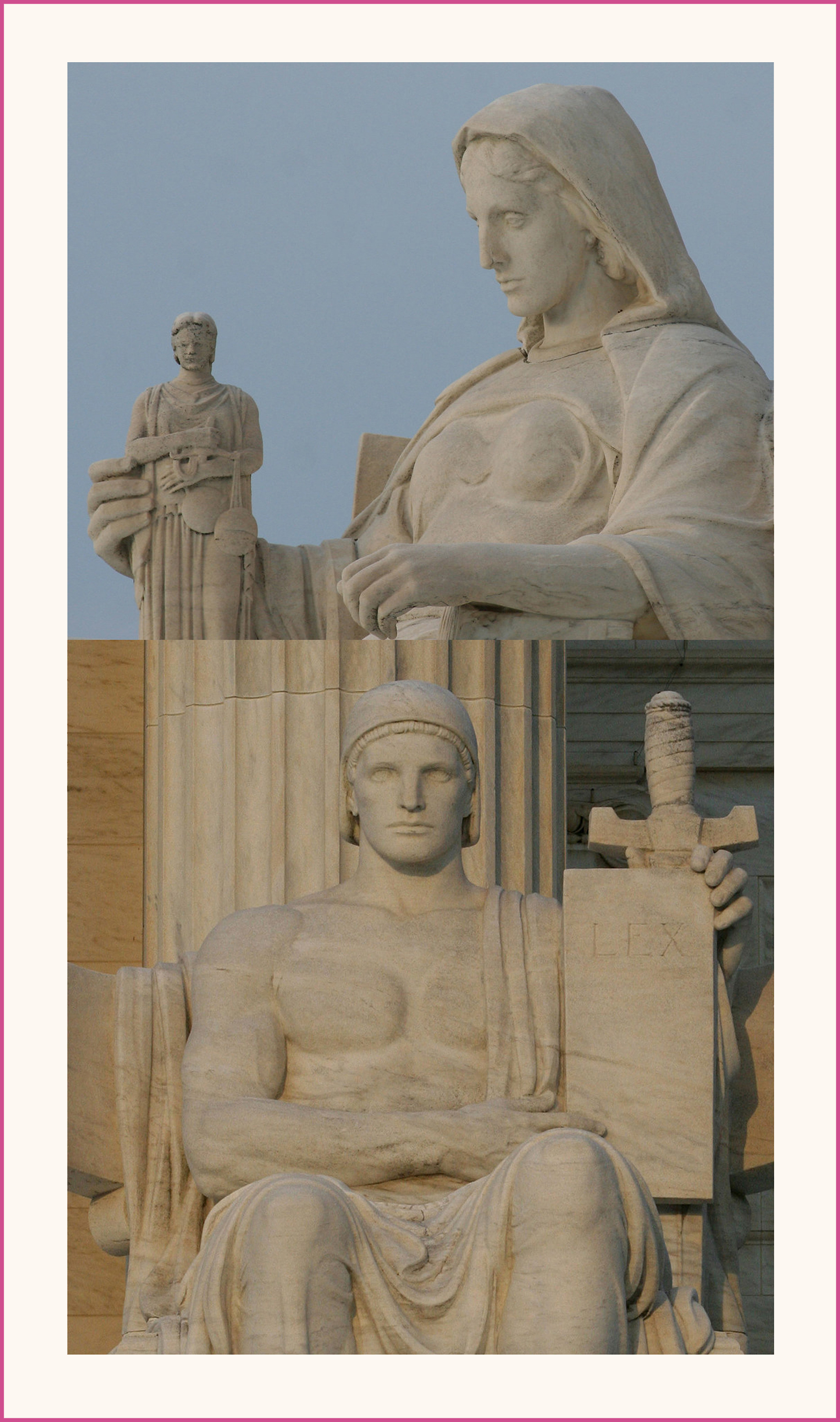
Figures 6 and 7
Fraser was a railroad engineer, sculptor, and alumni of The Art Institute of Chicago. He created the two marble figures that guard the entrance to The Supreme Court Building titled Authority of Law and Contemplation of Justice (figures 7 and 6). He assigned a gender to each statue, one male one female. Unsurprisingly, a male gender became the “authority” on law and the female figure became a “contemplator” of justice. German-American Sculptor and alumni of The Cooper Union, Weinman created the marble friezes depicting processions of “great lawgivers of history” installed in the eastern, western, northern, and southern walls of the interior of the courtroom. The suite of friezes prominently feature male figures demonstrating absolute power and mastery over the law while safeguarding the rights of people to pursue happiness.9
Men named Napoleon, John, William, Hugo, Louis, Justinian, Octavian, Confucius, Draco, Menes and Moses are depicted in Weinman’s friezes. Our Lady of Justice is around about the halls and the rooms, but she is a fictitious moral force personifying equanimity and fairness (fig. 10). She’s there for assurances that business conducted Monday to Friday 9 to 5 at One First Street is not dirty business, just business as usual. When law is executed impartially and in disregard of any individual's personality or character our lady does not need to look liars in the eye, right? We’ve been told that justice is blind.
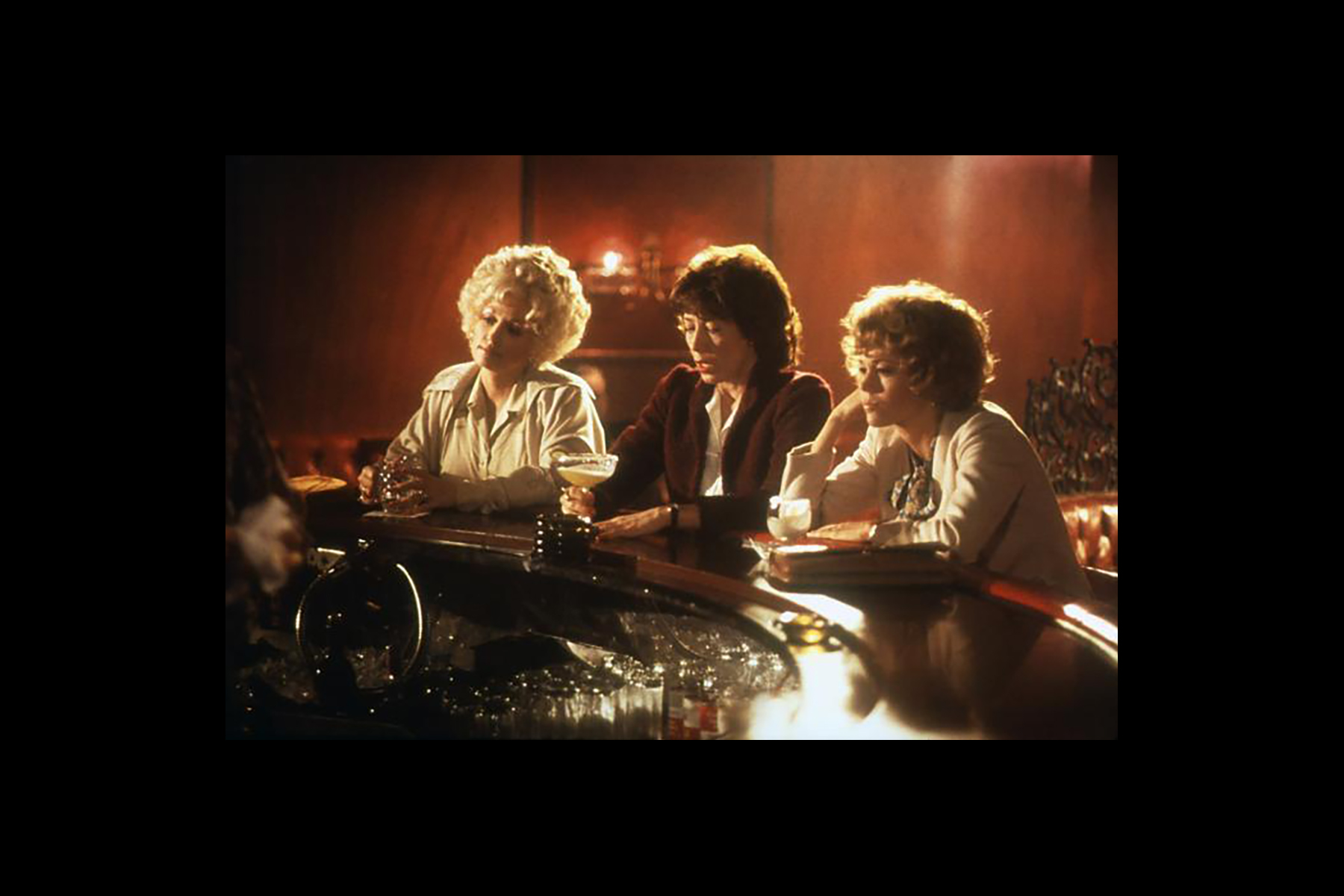
Figure 8
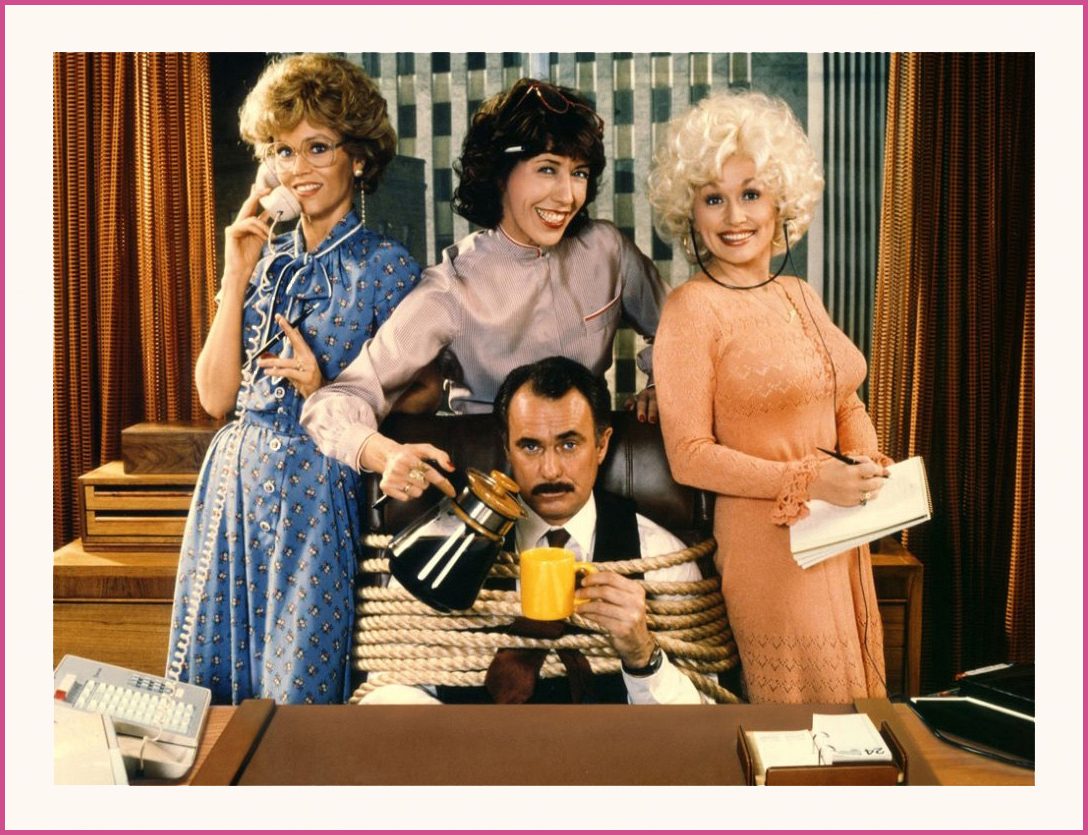
But law is not impartial and it is not executed without individuals acting in their own self-interests. The valorization of The Napoleonic Code in The Supreme Court as one case in point is problematic, telling, and disturbingly transparent in regard to familial code, which enforced male supremacy over women and children, and its maintenance of code noir in the early 19th century.11 If we’re really honest about the state of our democracy, this fictitious symbolic lady is really not “Our Lady of Justice,” she’s more our twisted sister. She’s our Violet, Doralee, and Judy before the holy trinity was formed that spiked Franklin Hart, Jr’s coffee with rat poison (figures 8 and then 9). Don’t think she can’t “change you from a rooster to a hen with one shot,” just because she’s been raised to forgive and forget.12

Figure 10
If our twisted sister could see what decisions her scales, mirror, and snake have inspired I imagine she would reanimate herself and evacuate the premises in search of a less macabre workplace to project utopian visions of justice. Somewhere less representative of the death of culture and democracy. Considering the above, it’s beginning to feel like the one-hundred and ten male justices in The Supreme Court’s two hundred and thirty year history have actually been trolling Our Lady of Justice. That’s not okay.
In 2020 alone, The Supreme Court of the United States has already made sixteen decisions. One in particular, Hernandez Et Al., v. Mesa, stands out for its discriminatory and partial ruling. Argued between November 12th, 2019 and February 25th, 2020, The Supreme Court ruled in favor of a U.S. Border Patrol Agent Jesus Mesa Jr. who shot and killed a fifteen-year-old Mexican National Sergio Adrián Hernández Güereca in 2010. At the time of Güereca’s death he was engaged in a culvert crossing game with friends between El Paso, Texas and Ciudad Juárez, Mexico. Güereca was murdered in Mexico by Agent Mesa who fired his shot across border lines from the United States, yet The Supreme Court’s ruling confirmed that Agent Mesa acted in accordance with the policies and training provided by the U.S. federal government and did not violate the Fourth Amendment to the U.S. Constitution baring unjust deadly force.
In 2020 alone, The Supreme Court of the United States has already made sixteen decisions. One in particular, Hernandez Et Al., v. Mesa, stands out for its discriminatory and partial ruling. Argued between November 12th, 2019 and February 25th, 2020, The Supreme Court ruled in favor of a U.S. Border Patrol Agent Jesus Mesa Jr. who shot and killed a fifteen-year-old Mexican National Sergio Adrián Hernández Güereca in 2010. At the time of Güereca’s death he was engaged in a culvert crossing game with friends between El Paso, Texas and Ciudad Juárez, Mexico. Güereca was murdered in Mexico by Agent Mesa who fired his shot across border lines from the United States, yet The Supreme Court’s ruling confirmed that Agent Mesa acted in accordance with the policies and training provided by the U.S. federal government and did not violate the Fourth Amendment to the U.S. Constitution baring unjust deadly force.
The majority ruling argued:
In other words, Border Patrol acts in accordance with the executive branch’s foreign policy and the matter is more appropriately reconciled at a federal level through diplomacy (fig. 11). Case dismissed.
Yet, “GINSBURG, J., filed a dissenting opinion, in which BREYER, SOTOMAYOR, and KAGAN, JJ., joined.” Ginsburg’s dissent describes the injustice of the ruling in thirteen pages and frames the circumstances around Sergio Adrián Hernández Güereca’s murder as both tragic and worthy of the most serious consideration of the court. The dissenting opinion against Hernandez Et Al., v. Mesa’s ruling gives an alternative account of the case. One where a rogue federal law enforcement using unreasonable deadly force in violation of both the Fourth and the Fifth Amendments has acted against his official duties.14
A cross border shooting affects the interests of two countries, and as it happened here, may lead to disagreement. It is not for this Court to arbitrate between the United States and Mexico, which both have legitimate and important interests at stake and have sought to reconcile those interests through diplomacy.13
In other words, Border Patrol acts in accordance with the executive branch’s foreign policy and the matter is more appropriately reconciled at a federal level through diplomacy (fig. 11). Case dismissed.
Yet, “GINSBURG, J., filed a dissenting opinion, in which BREYER, SOTOMAYOR, and KAGAN, JJ., joined.” Ginsburg’s dissent describes the injustice of the ruling in thirteen pages and frames the circumstances around Sergio Adrián Hernández Güereca’s murder as both tragic and worthy of the most serious consideration of the court. The dissenting opinion against Hernandez Et Al., v. Mesa’s ruling gives an alternative account of the case. One where a rogue federal law enforcement using unreasonable deadly force in violation of both the Fourth and the Fifth Amendments has acted against his official duties.14
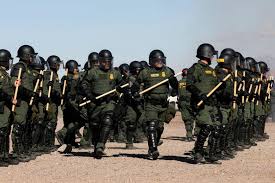
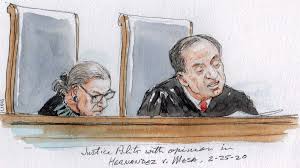
Figure 11
SInce this article was written an additional four decisions have been made by the U.S. Supreme Court. Notably, the decision made in regard to Wisconsin’s general elections on April 7th, 2020 threatened the health and lives of American citizens.
SInce this article was written an additional four decisions have been made by the U.S. Supreme Court. Notably, the decision made in regard to Wisconsin’s general elections on April 7th, 2020 threatened the health and lives of American citizens.
Figure 12
A courtroom sketch rendering Justice Samuel Anthony Alito Jr. reading the majority opinion next to Justice Ruth Bader Ginsburg, reveals a glimpse of Justice Alito’s tie and Justice Ginsburg’s jabot
A courtroom sketch rendering Justice Samuel Anthony Alito Jr. reading the majority opinion next to Justice Ruth Bader Ginsburg, reveals a glimpse of Justice Alito’s tie and Justice Ginsburg’s jabot
A courtroom sketch rendering Justice Samuel Anthony Alito Jr. reading the majority opinion next to Justice Ruth Bader Ginsburg, reveals a glimpse of Justice Alito’s tie and Justice Ginsburg’s jabot (fig. 12). The tie Justice Alito is wearing is red. Red is the color associated with The Republican Party (or GOP, aka Grand Old Party), his affiliated party. The jabot Justice Ginsburg is wearing is her notorious “dissent” collar, identified by Ginsburg in a 2014 Katie Couric mini-feature of her infamous neckwear collection. Couric asks Ginsburg during the interview, “Why is that [for dissent]?” Ginsburg replies, “It looks fitting for dissent.”15 Notably, Justice Ginsburg wore this jabot when accused rapist Brett Kavanaugh was appointed to The Supreme Court. His tie is red, her collar is piercing. Side by side, these neck pieces indicate that neither dismissal, nor dissent are impartial.
As one of four female Supreme Court Justices, Justice Ginsburg’s jabots are an essential accessory, one that signifies through the official wardrobe that a woman is present to master and exercise authority over the law. Has there ever been a cockyer accessory worn in the history of fashion than a female justices’ official frills? They are visual signifiers, reminding The Supreme Court that underrepresented persons can create and choose how history is written. What could be more threatening to the state of our present day “democracy”?
Nothing save for acid rain or Justice Ginsburg’s jabots.
As one of four female Supreme Court Justices, Justice Ginsburg’s jabots are an essential accessory, one that signifies through the official wardrobe that a woman is present to master and exercise authority over the law. Has there ever been a cockyer accessory worn in the history of fashion than a female justices’ official frills? They are visual signifiers, reminding The Supreme Court that underrepresented persons can create and choose how history is written. What could be more threatening to the state of our present day “democracy”?
Nothing save for acid rain or Justice Ginsburg’s jabots.
ENDNOTES
1 ---- Definition & Meaning Jabot, dictionary.university/Jabot.
2 ---- “What Does Jabot Mean.” What Does Jabot Mean - Definition of Jabot - Word Finder, findwords.info/term/jabot.
3 ---- “Jabot.” Fashion Encyclopedia, www.fashionencyclopedia.com/fashion_costume_culture/European-Culture-18th-Century/Jabot.html
3 ---- Bigelow, Marybelle S. Fashion in History: Apparel in the Western World. Minneapolis, MN: Burgess Publishing, 1970.
4 ---- You Are Being Redirected..., joshblackman.com/blog/2010/12/27/kagan-on-not-wearing-a-neck-doily-in-my-real-life-im-not-a-frilly-lacy-person/.
5 ---- “Justices Have Differing Views of Order in the Court.” The Washington Post, WP Company, 4 Sept. 2009, www.washingtonpost.com/wp-dyn/content/article/2009/09/03/AR2009090303790.html.
6 ---- ibid.
7 ---- “Acid Rain's Slow Dissolve.” National Parks Service, U.S. Department of the Interior, www.nps.gov/nama/blogs/acid-rains-slow-dissolve.htm.
8 ---- “Acid Rain: Scourge of the Past or Trend of the Present?” NSF, www.nsf.gov/discoveries/disc_summ.jsp?cntn_id=124955.7
9 --- Building Features, www.supremecourt.gov/about/buildingfeatures.aspx.
10 ---- https://www.reaganfoundation.org/ronald-reagan/white-house-diaries/diary-entry-02141981/
11 --- Napoleon revoked the “Law of February 4, 1794,” a law that abolished slavery in French held territory in 1804. “The Civil Code Index.” The Napoleon Series, The Waterloo Association, www.napoleon-series.org/research/government/c_code.html
12 --- “Nine To Five Script - Dialogue Transcript.” Nine To Five Script - Transcript from the Screenplay and/or Dolly Parton, Lily Tomlin, and Jane Fonda Movie, www.script-o-rama.com/movie_scripts/n/nine-to-five-script-transcript.html.
13 ---- “2008 Term Opinions of the Court.” Home - Supreme Court of the United States, www.supremecourt.gov/opinions/slipopinion/19.
14 ---- ibid.
15 ---- “Justice Ginsburg Exhibits Her Famous Collar Collection.” Yahoo! News, Yahoo!, 31 July 2014, news.yahoo.com/video/justice-ginsburg-exhibits-her-famous-194517521.html.
FIGURES / SOURCES
1. United States Supreme Court Building - Courtroom, August 2017, © Gerhard Huberhttps://global-geography.org/af/Geography/America/United_States/Pictures/Washington/United_States_Supreme_Court_Building_-_Courtroom
2. EU Observer https://euobserver.com/smoke-and-mirrors/126124
3. Small Bones Studio Etsy https://www.etsy.com/listing/130057984/beautiful-victorian-lace-jabot?share_id=10715402&hmac=3845b83fc848f86d6c9de381568432a7f6b87bd9&utm_source=Pinterest&utm_medium=PageTools&utm_campaign=Share
4. Irving Penn for The New Yorker https://www.newyorker.com/magazine/2018/10/08/ruth-bader-ginsburgs-unlikely-path-to-the-supreme-court
5. Atlas Obscura https://www.atlasobscura.com/articles/hubbard-brook-experimental-forest
6. David from FLIKR https://www.flickr.com/photos/bootbearwdc/
7. Wikicommons https://commons.wikimedia.org/wiki/File:%22Authority_of_Law%22_by_James_Earle_Fraser.jpg
9. https://pastimes13.wordpress.com/tag/9-to-5/
10. Our Lady of Justice, Illustration by Angela Berry and Shaun O'Dell
11. Herika Martinez/AFP via Getty Images https://slate.com/news-and-politics/2020/03/supreme-court-immigration-cbp-killing-hernandez-mesa-bivens.html
12. Courtroom Drawing by Art Lien https://www.scotusblog.com/2020/02/opinion-analysis-justices-block-cross-border-shooting-lawsuit/
1 ---- Definition & Meaning Jabot, dictionary.university/Jabot.
2 ---- “What Does Jabot Mean.” What Does Jabot Mean - Definition of Jabot - Word Finder, findwords.info/term/jabot.
3 ---- “Jabot.” Fashion Encyclopedia, www.fashionencyclopedia.com/fashion_costume_culture/European-Culture-18th-Century/Jabot.html
3 ---- Bigelow, Marybelle S. Fashion in History: Apparel in the Western World. Minneapolis, MN: Burgess Publishing, 1970.
4 ---- You Are Being Redirected..., joshblackman.com/blog/2010/12/27/kagan-on-not-wearing-a-neck-doily-in-my-real-life-im-not-a-frilly-lacy-person/.
5 ---- “Justices Have Differing Views of Order in the Court.” The Washington Post, WP Company, 4 Sept. 2009, www.washingtonpost.com/wp-dyn/content/article/2009/09/03/AR2009090303790.html.
6 ---- ibid.
7 ---- “Acid Rain's Slow Dissolve.” National Parks Service, U.S. Department of the Interior, www.nps.gov/nama/blogs/acid-rains-slow-dissolve.htm.
8 ---- “Acid Rain: Scourge of the Past or Trend of the Present?” NSF, www.nsf.gov/discoveries/disc_summ.jsp?cntn_id=124955.7
9 --- Building Features, www.supremecourt.gov/about/buildingfeatures.aspx.
10 ---- https://www.reaganfoundation.org/ronald-reagan/white-house-diaries/diary-entry-02141981/
11 --- Napoleon revoked the “Law of February 4, 1794,” a law that abolished slavery in French held territory in 1804. “The Civil Code Index.” The Napoleon Series, The Waterloo Association, www.napoleon-series.org/research/government/c_code.html
12 --- “Nine To Five Script - Dialogue Transcript.” Nine To Five Script - Transcript from the Screenplay and/or Dolly Parton, Lily Tomlin, and Jane Fonda Movie, www.script-o-rama.com/movie_scripts/n/nine-to-five-script-transcript.html.
13 ---- “2008 Term Opinions of the Court.” Home - Supreme Court of the United States, www.supremecourt.gov/opinions/slipopinion/19.
14 ---- ibid.
15 ---- “Justice Ginsburg Exhibits Her Famous Collar Collection.” Yahoo! News, Yahoo!, 31 July 2014, news.yahoo.com/video/justice-ginsburg-exhibits-her-famous-194517521.html.
FIGURES / SOURCES
1. United States Supreme Court Building - Courtroom, August 2017, © Gerhard Huberhttps://global-geography.org/af/Geography/America/United_States/Pictures/Washington/United_States_Supreme_Court_Building_-_Courtroom
2. EU Observer https://euobserver.com/smoke-and-mirrors/126124
3. Small Bones Studio Etsy https://www.etsy.com/listing/130057984/beautiful-victorian-lace-jabot?share_id=10715402&hmac=3845b83fc848f86d6c9de381568432a7f6b87bd9&utm_source=Pinterest&utm_medium=PageTools&utm_campaign=Share
4. Irving Penn for The New Yorker https://www.newyorker.com/magazine/2018/10/08/ruth-bader-ginsburgs-unlikely-path-to-the-supreme-court
5. Atlas Obscura https://www.atlasobscura.com/articles/hubbard-brook-experimental-forest
6. David from FLIKR https://www.flickr.com/photos/bootbearwdc/
7. Wikicommons https://commons.wikimedia.org/wiki/File:%22Authority_of_Law%22_by_James_Earle_Fraser.jpg
9. https://pastimes13.wordpress.com/tag/9-to-5/
10. Our Lady of Justice, Illustration by Angela Berry and Shaun O'Dell
11. Herika Martinez/AFP via Getty Images https://slate.com/news-and-politics/2020/03/supreme-court-immigration-cbp-killing-hernandez-mesa-bivens.html
12. Courtroom Drawing by Art Lien https://www.scotusblog.com/2020/02/opinion-analysis-justices-block-cross-border-shooting-lawsuit/